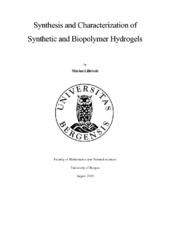Synthesis and characterization of synthetic and biopolymer hydrogels
Master thesis

View/
Date
2019-09-04Metadata
Show full item recordCollections
- Department of Chemistry [432]
Abstract
Hydrogels are widely researched for biomedical applications such as drug delivery. The tunable properties of hydrogels, in terms of swelling, mechanical properties and mesh size, make them prime candidates for this application. Synthetic polymers display superior mechanical properties and swelling ability, but their toxicity, and lack of biodegradability and biocompatibility is problematic. Biopolymer hydrogels synthesized with either reduced, or without toxic crosslinker agents, could provide viable alternatives for biomedical applications. This study details the approaches for synthesis of three main hydrogel formulations. The hydrogels were characterized by oscillatory rheological measurements, dynamic swelling, and pulsed gradient spin-echo NMR. Poly(NIPAM-co-AAc) was synthesized by free radical polymerization, using a the redox couple (APS/TEMED) as initiators, and DAT as crosslinker. The hydrogel displayed good mechanical properties. Mass swelling ratio was shown to be greatly influenced by initiator ratio. Self-assembling chitosan (SA-CS) hydrogel was prepared under mild reaction conditions. Crosslinking by Michael addition was performed by mixing of maleimide-modified and thiolated chitosan. Inconclusive results indicated the formation a weak reversible network, as well as a covalently crosslinked network with satisfactory swelling ability and mechanical properties. Chitosan-gelatin hydrogel was dissolved in acetic acid and co-crosslinked by glutaraldehyde and sodium sulfate. Oscillatory rheological measurements indicated a trend between increasing amount of sodium sulfate and decreasing storage modulus. Dissolution in aqueous media and lack of swelling suggests it is an inadequate alternative to poly(NIPAM-co-AAc).